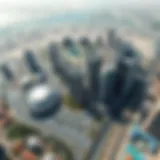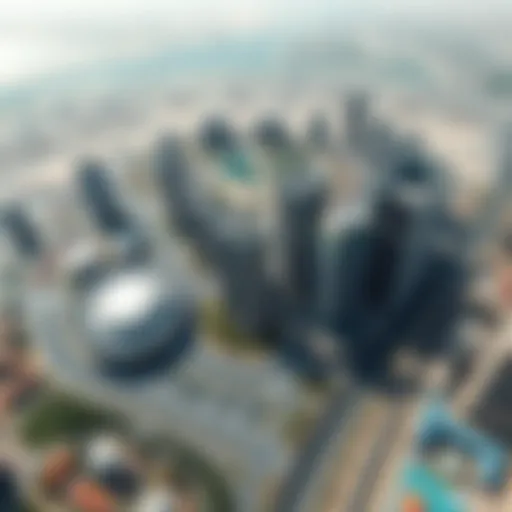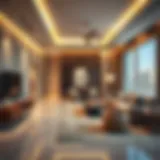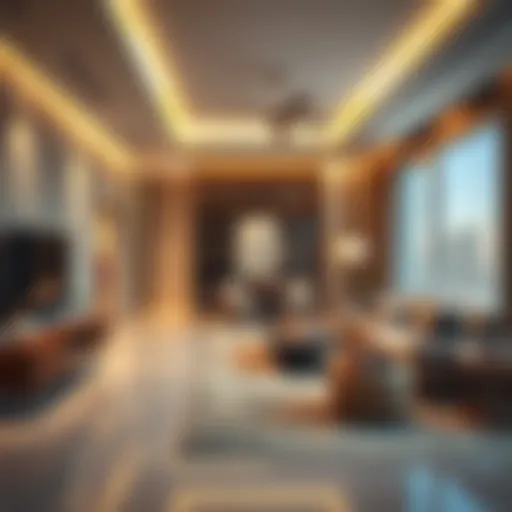Exploring Green City Al Quoz: Dubai's Sustainable Oasis


Intro
In the heart of Dubai, amid the hustle and bustle of a city famed for its dramatic skyline and luxurious lifestyles, lies a remarkable venture that seeks to shift the focus from mere urbanization to sustainability. The project, Green City Al Quoz, embodies an innovative approach to urban living. It is not just a neighborhood; it is a statement of intent toward a greener, more sustainable future. This section peels back the layers of this oasis, offering insights into its unique characteristics, the lifestyle it nurtures, and the economic implications for those who reside and work there.
Area Overview
Neighborhood Characteristics
Green City Al Quoz is distinct from other areas in Dubai, primarily due to its integration of nature into urban development. The project emphasizes green spaces, sustainable transportation, and eco-friendly architecture, creating an area where people can thrive physically and psychologically. Imagine winding pathways lined with native plants, communal gardens bursting with life, and open spaces fostering community interaction.
This neighborhood is designed with a clear vision – to promote a lifestyle that cherishes both modern conveniences and the environment. Among its architectural highlights, you can find buildings crafted with energy-efficient materials, solar panels adorning rooftops, and rainwater harvesting systems subtly embedded into structures. The area has become a model showcasing how urban living can coexist with nature.
- Green spaces, parks & community gardens foster social interaction.
- Architectural designs focus on sustainability & efficiency.
- A vision promoting health and nature-centric lifestyles.
Cost of Living Analysis
Living in Green City Al Quoz comes with its unique set of financial considerations. While it might not be the cheapest area in Dubai, those who believe in investing in sustainable living find the cost justified. Housing options vary widely, ranging from modern apartments to family-sized homes, catering to different income brackets.
Typically, the rent in this sustainable haven reflects the values it embodies. You might pay more for residences that offer features like energy efficiency, proximity to green spaces, or community-oriented designs. However, the long-term savings through lower utility costs and improved well-being are considerable.
"Investing in areas like Green City Al Quoz isn't merely a transaction; it's a commitment to a lifestyle that values sustainability and community."
For expatriates, locals, and even real estate agents, understanding the nuances of what you get in terms of value versus expense is crucial.
Lifestyle Insights
Cultural and Recreational Activities
Life in Green City Al Quoz is rich with cultural experiences and recreational activities. The area hosts a variety of community events that revolve around sustainability. Local farmers' markets, eco-friendly workshops, and art installations encourage residents to engage and connect with one another. These events highlight the vibrant community spirit, where residents come together to share their creative talents and sustainable practices.
With its proximity to Dubai's cultural hubs, residents can enjoy festivals, art shows, and performance arts with ease. Every corner of this neighborhood breathes creativity, reminding everyone that a sustainable lifestyle is about enriching experiences and community ties.
- Engage in workshops promoting eco-friendly practices.
- Experience local art exhibitions and performances.
- Participate in regular community events fostering connections.
Local Dining Experiences
Food in Green City Al Quoz is another reflection of its values. Restaurants and cafes emphasize locally-sourced ingredients and sustainable practices, offering menus filled with organic and seasonal options. Whether it's a cozy café serving fair-trade coffee, or a fine dining restaurant promoting innovation through plant-based gastronomy, every dining experience is curated with a conscience.
Establishments often feature gardens on-site, where fresh herbs and vegetables flourish, bridging the gap between Earth and table. This not only enhances the dining experience but nurtures a deeper appreciation of food among residents.
- Variety of restaurants promoting healthy, local choices.
- Cafés encouraging slow food dining experiences.
- Opportunities to learn about sustainable food practices in an enjoyable setting.
Prologue to Green City Al Quoz
Green City Al Quoz has emerged as a beacon of sustainability in the heart of Dubai, embodying the intersection where urban development meets environmental stewardship. The concept of a green city is not merely an architectural ambition; it reflects a pivotal shift in how communities can synthesize modern living with respect for the natural world. Understanding the intricacies of this initiative is vital, especially for expatriates, tourists, locals, and real estate agents who are keen on sustainable living.
In a world grappling with the pressing challenges of climate change, urban sprawl, and resource depletion, Green City Al Quoz serves as a critical reminder of the potential for cities to adapt and thrive in harmony with their surroundings. This utopia is not just a green carpet laid over an urban landscape; it is a complex and conscientious approach to urban planning that prioritizes efficiency, community engagement, and environmental responsibility.
Overview of the Green City Initiative
The Green City Initiative is at the heart of Al Quoz's transformation. Initiated as part of Dubai's broader vision for sustainable development, this initiative seeks to integrate sustainability into every facet of city life. From energy conservation practices to eco-friendly public transport systems, the initiative aims to minimize the carbon footprint of the community.
This project does not work in isolation. It aligns with internationally recognized standards for sustainable cities, often referred to as Smart Cities. For example, smart waste management systems are being implemented that allow for real-time monitoring of waste collection and recycling processes. Additionally, the focus on green buildings not only elevates the aesthetic value of Al Quoz but also enhances energy efficiency overall.
"Green City Al Quoz is a pioneering model, blending urban development with a commitment to environmental integrity."
Significance of Al Quoz Location
Al Quoz's geographical position adds layers of significance to the Green City Project. Nestled between major highways and close to the bustling center of Dubai, this location offers both accessibility and a fresh perspective on urban living.
The very essence of a sustainable community relies on how well it connects with its surrounding areas. Al Quoz is strategically located to facilitate easy travel for residents and visitors alike, promoting public transit and reducing reliance on private vehicles. This connectivity is vital for encouraging foot traffic in commercial areas, ultimately boosting local businesses.
Moreover, Al Quoz is historically rich, embodying Dubai's artistic spirit with galleries, cultural centers, and community art spaces. By ensuring that sustainability and culture go hand in hand, the initiative respects the area's legacy while forging a robust future. This harmonious blend positions Green City Al Quoz not just as a physical space, but as a living, breathing example of what a sustainable urban environment can look like.
Sustainable Urban Development Principles


Sustainable urban development stands as a cornerstone in the vision of Green City Al Quoz, intertwining ecological health with urban life. This initiative pivots around the premise of creating a livable environment that harmonizes with nature. In this section, we will explore various principles that steer this initiative toward a more sustainable future, encompassing the integration of natural elements into architectural endeavors, implementing energy-efficient technologies, and establishing effective water conservation measures.
Integration of Nature and Architecture
The marriage of nature and architecture is not just a buzzword; it’s a crucial step in making cities livelier and more sustainable. In Green City Al Quoz, architects and city planners are not merely placing buildings; they’re crafting spaces that breathe. Using biophilic design principles, structures incorporate natural elements like trees and gardens right into their frameworks. For instance, buildings are adorned with vertical gardens—simply put, plants growing up the sides of structures—which offer both aesthetic appeal and environmental benefits like shade and air purification.
Furthermore, in an oasis such as this, natural landscapes are preserved. Parks are dotted throughout neighborhoods, fostering community gathering spots where families can picnic or children play. This integration not only beautifies the urban area but also enhances residents' mental well-being. Civic engagement comes alive in these green spots; local gardening clubs may pop up or informal get-togethers occur, which helps to foster a sense of belonging.
Energy Efficiency Strategies
Energy efficiency isn’t just a lofty goal; it’s a must in today’s world, especially in regions with intense heat like Dubai. Green City Al Quoz adopts a mindset of innovation, employing various technologies to reduce energy consumption. Installing solar panels on rooftops isn’t just smart; it leverages the relentless sun to power homes and businesses. Additionally, buildings feature smart meters that provide real-time data on energy usage, allowing inhabitants to adjust consumption accordingly.
Beyond reliance on renewable energy, the city employs advanced insulation techniques and energy-efficient appliances which minimize the demand for cooling systems. The layout of communities is also strategically planned to encourage walking or biking, further reducing reliance on cars. These efforts don't just cater to the planet; they also translate into significant cost savings for residents, making it a win-win situation.
Water Conservation Measures
Water, a scarce resource in arid regions, requires careful management. Green City Al Quoz implements various water conservation measures that are critical for sustainability. First off, rainwater harvesting systems are integrated into residential and commercial buildings to collect and store water for irrigation. This practice resonates with the adage, "make hay while the sun shines," emphasizing the need to maximize available resources.
Moreover, using drought-resistant landscaping forms a foundational aspect of urban design in Al Quoz. Residents opt for native plants that naturally thrive in the climate, significantly reducing the need for additional watering. The use of smart irrigation systems, which adjust watering schedules based on weather patterns, serves as another layer of efficiency. Through these strategies, the community not only preserves water but cultivates an innate understanding of its value.
"Sustainable urban development is not the responsibility of any one group; it’s a collaboration of everyone—citizens, government, and businesses alike—working together to create a better future."
For more details on sustainable practices, you can check Wikipedia or Britannica.
Impact on Community and Lifestyle
The concept of sustainability transcends just technical achievements; it deeply intertwines with the community's way of life. In the heart of Dubai, Green City Al Quoz redefines urban living, showcasing how a well-thought-out design can create a positive ripple effect across various aspects of life. It’s not merely about buildings and roads — it’s about nurturing a more engaged, healthier, and economically vibrant community.
Job Creation and Economic Opportunities
At the forefront of Green City Al Quoz’s impact is its ability to bolster job creation. By developing a mosaic of industries tied into the city’s green ethos, the initiative opens doors to diverse economic opportunities. Various sectors, from renewable energy firms to local artisans, find a home here, sparking a thriving job market. The commitment to sustainability necessitates skilled workers who can engage in eco-friendly practices, promoting the need for educational and vocational training programs.
- New Industries: Construction of eco-friendly buildings encourages green technology firms to set up shop.
- Skills Development: Partnerships with local educational institutions pave the way for specialized training.
- Community Involvement: Participation in workshops creates a sense of ownership and engagement.
For expatriates seeking employment, the dynamic environment of Green City Al Quoz presents unique opportunities that showcase their talents and accommodate their skill sets. Moreover, by prioritizing local hiring, the initiative promotes a sense of community pride, making it a win-win scenario for everyone involved.
Enhancing Quality of Life
Quality of life within Green City Al Quoz is fundamentally elevated through thoughtful urban planning that marries aesthetics with functionality. Spaces that prioritize health and well-being, such as parks and leisure areas, provide residents — both long-term and newcomers — a sanctuary amidst the bustling city. The introduction of vibrant green spaces goes beyond mere beauty; it fosters a connection to nature that urban dwellers often crave.
- Community Spaces: Public parks encourage social interactions, breaking down language and cultural barriers among residents.
- Health Benefits: Access to more green spaces is linked to improved physical and mental health.
- Sustainable Transportation: Walkable paths and bike lanes create convenience, reducing reliance on cars.
As part of daily life, sustainability in Green City Al Quoz reflects in local businesses that prioritize eco-friendly products, thus supporting the health conscious community. Consequently, as inhabitants engage in environmentally responsible behaviors, they also cultivate a lifestyle that respects both personal well-being and the ecosystem.
The success of Green City Al Quoz exemplifies how sustainable urban design can foster economic resilience while enhancing overall quality of life.
Thus, it stands not just as a model for urban development but as a vibrant, living testament to the potential of sustainable communities, where economic and lifestyle enhancements go hand in hand.
Architectural Highlights
The architectural highlights of Green City Al Quoz stand as a testament to modern sustainable living. This section aims to delve into how the innovative designs and thoughtfully planned recreational areas enhance the overall quality of life for residents and visitors alike. The interplay of aesthetics with functionality creates not just buildings, but a vibrant ecosystem.
Innovative Building Designs
Innovative building designs in Al Quoz reflect more than just contemporary aesthetics; they embody a vision aimed at harmonizing urban living with nature. Structures are crafted to optimize energy efficiency while being visually appealing. Large windows and open spaces allow for natural light to permeate interiors, reducing reliance on artificial lighting and thus saving energy.
Materials play a significant role in the design philosophy. Eco-friendly materials, like reclaimed wood and recycled metals, are favored in construction. This choice not only lowers the carbon footprint but also contributes to a unique character that differentiates the buildings here from those in traditional cityscapes. For instance, the organic shapes of certain structures mimic natural forms, blending seamlessly with the green environment.
"Architecture is the art of how to waste space." - Philip Johnson
This quote resonates deeply within the urban design of Al Quoz, where every inch is meticulously planned to serve a purpose. The innovative approach goes beyond mere aesthetics; it seeks to foster community engagement and ecological harmony, proving that good architecture can indeed influence social behavior.
Green Spaces and Recreational Areas
Green spaces and recreational areas are the lifeblood of Green City Al Quoz. These spaces offer a breath of fresh air amid the urban sprawl, providing residents and visitors with an escape to nature. Parks filled with native flora not only enhance the visual appeal but also support local biodiversity.
Walking trails wind through lush gardens, allowing for leisurely strolls that can be both relaxing and invigorating. Playgrounds and sports facilities cater to families and fitness enthusiasts, ensuring a vibrant community atmosphere. The design incorporates various elements, like outdoor fitness stations and picnic areas, making it a multi-functional space.
- Tree-lined avenues create natural shade, encouraging outdoor activities even in the warmer months.
- Community gardens offer residents the chance to engage in sustainable practices, such as growing their own vegetables and flowers.
- Art installations dotted throughout these recreational areas foster local talent while adding a cultural dimension to the physical landscape.


Cultural Relevance and Community Engagement
The cultural fabric of a community is woven not just through buildings and infrastructure but through the vibrant expressions of its inhabitants. In Green City Al Quoz, this importance is underlined by the emphasis on cultural relevance and community engagement. The initiative aims to foster a sense of belonging and collective identity among its residents by encouraging local participation in various creative and communal endeavors. This connection to culture not only enriches community spirit but also attracts visitors, further enhancing the sustainability model of this urban oasis.
Local Art Installations and Exhibitions
Art is a powerful medium for expression, bridging gaps between diverse communities. In Green City Al Quoz, local art installations serve as a canvas that reflects the ethos of the area and its inhabitants. These installations are typically crafted by local artists, embedding cultural narratives and contemporary perspectives into the public space.
- Diverse Themes: The artworks often showcase themes central to Arabian culture, sustainability, and the beauty of nature, creating a dialogue between tradition and modernity.
- Interactive Exhibits: Many of the installations invite interaction. For example, sculptures might incorporate elements that change with the weather or community-driven projects where residents contribute layers of paint or decoration.
One striking example includes a large mural depicting traditional Emirati life, combined with elements of modern cityscapes, symbolizing the harmonious coexistence of past and future. These pieces not only beautify the environment but also serve as landmarks that foster community pride and local tourism.
"Art is the most beautiful of all lies; it can take the mundane and elevate it to the extraordinary." This idea resonates deeply in the avenues of Green City Al Quoz, where art meets the heart of daily life.
Community Events and Initiatives
Community engagement initiatives in Green City Al Quoz are designed to forge connections among residents, promote collaboration, and celebrate local culture. From seasonal festivals to health and wellness fairs, these events create spaces for residents to engage and share experiences.
- Local Workshops: Regular workshops encourage skill-sharing among residents. Be it pottery, painting, cooking, or sustainable gardening, the variety of activities allows everyone to contribute their unique talents and learn from one another.
- Cultural Celebrations: Annual events celebrate key cultural festivals, integrating traditional music, art, and cuisine. Such celebrations help bring families together, instilling a sense of community and belonging.
Moreover, community-led initiatives often find their genesis through local dialogue, addressing pertinent issues like waste management and green space maintenance. When residents come together to discuss and resolve challenges, it leads to enhanced collective responsibility and care for the community environment.
Environmental Benefits
The importance of environmental benefits in the context of Green City Al Quoz cannot be overstated. This initiative symbolizes a significant step towards redefining urban living by placing a strong emphasis on minimizing ecological footprints while enhancing quality of life. As such, it encapsulates a wide array of benefits that not only promote sustainability but also foster resilience against the challenges of urbanization. The primary aspects of these benefits encapsulate biodiversity, ecosystem restoration, and combating heat-related urban challenges.
Biodiversity and Ecosystem Restoration
Biodiversity plays a crucial role in maintaining the balance of ecosystems, and Green City Al Quoz takes this seriously. The initiative has been developed with the express purpose of enhancing natural habitats within Dubai's oft-harsh desert landscape.
By planting indigenous vegetation and introducing wildlife-friendly spaces, the area aims to serve as a sanctuary for native species. This is especially poignant in an urban setting where natural habitats are rapidly depleting. The project features:
- Native plants: These require less water and are more resilient to local temperatures, significantly reducing overall resource consumption.
- Wildlife corridors: As a means to allow animals to move safely within urban confines, promoting genetic diversity and a healthy ecosystem.
- Community gardens: Engaging local residents in sustainable practices while helping to restore the natural ecosystem.
This proactive approach towards biodiversity not only resonates with environmental ethics but also encourages community participation, creating a shared responsibility for ecological stewardship.
Reducing Urban Heat Islands
One of the pressing environmental challenges in cities like Dubai is the phenomenon known as urban heat islands (UHIs). These areas tend to be significantly warmer than their rural counterparts due to human activities and the prevalence of concrete structures. Green City Al Quoz tackles this issue head-on, employing a variety of strategies to combat excessive heat and its associated implications.
The main strategies include:
- Green roofs: These installations not only provide insulation for buildings but also cool the surrounding environment through evapotranspiration.
- Tree canopies: Strategically placed trees offer shade and reduce the heat absorbed by pavements and buildings, eventually leading to a cooler microclimate.
- Reflective materials: Utilization of materials designed to reflect heat, thereby lowering surface temperatures in critical areas.
By addressing urban heat islands, Green City Al Quoz contributes significantly towards decreasing energy demands for cooling, promoting a more sustainable urban lifestyle.
"As cities grow, our ability to innovate and adapt will determine the quality of life for future generations."
In summary, the environmental benefits of Green City Al Quoz not only enhance the immediate locale but also contribute to a more sustainable future. The integration of biodiversity and thoughtful urban design plays a fundamental role in creating a healthier, more resilient urban ecosystem, setting a high bar for urban planning worldwide.
Challenges and Criticism
Green City Al Quoz, despite its progressive vision and ambitious goals, faces a number of challenges and criticisms that merit attention. This section sheds light on these factors, emphasizing their significance in understanding the evolution of this urban initiative. Analyzing these challenges is crucial, not just for identifying areas of improvement, but also in framing constructive dialogues around sustainable urban development. Here, we will explore the delicate balancing act between development and sustainability, as well as the community's response to ongoing urban changes.
Balancing Development with Sustainability
One of the core tensions in the Green City Al Quoz initiative is balancing robust development with the tenets of sustainability. As Dubai looks to expand and modernize, the pressures to accommodate residential and commercial growth can clash with the ideals of environmental stewardship. The project seeks to create a sustainable urban environment, but the reality often presents complex dilemmas.
For instance, the logistics of building new structures can lead to significant resource consumption and waste generation, countering the green objectives intended for the neighborhood. There’s often a poignant struggle to ensure that new developments are not merely shiny facades that conceal underlying unsustainable practices. A delicate equilibrium must be struck; the planners, architects, and stakeholders need to work closely to harmonize the expansion goals with eco-friendly methods and materials.
In this environment, discussions about zoning laws and construction permits come into play. Developers may prioritize quick returns on investment, nudging them away from sustainable practices. Addressing this requires rigorous oversight and an adaptable framework for sustainable building practices. Ultimately, the goal here is to create a model that demonstrates urban growth can coexist with a commitment to environmental preservation.
Community Response to Urban Changes
The response from the community regarding the transformations in Al Quoz has been mixed, weaving together concern, enthusiasm, and skepticism. Many residents and local businesses recognize the benefits that a modernized community can bring, such as enhanced amenities and increased tourism. However, some express worry about their eroding heritage and local culture amid this shift.


"The city is changing so quickly, it feels like we’re losing a part of our identity in the process," remarked one local shop owner.
Disproportionate benefits often lead to divisions within the community. While some groups thrive amid the urban melding of modern and natural elements, others feel marginalized, fearing that their voices might be overshadowed in the planning dialogues. Engaging community leaders and fostering open communication can pave the way for a more inclusive approach, ensuring that all voices are heard and valued.
Moreover, the psychological impacts of living in an evolving landscape cannot be overlooked. The disorientation or unease that some residents experience can stem from significant structural changes in their neighborhoods, prompting a demand for maintaining some sense of continuity amid transformation. The provision of shared spaces, parks, and community gathering spots is useful here—facilitating interactions and reinforcing local identity.
In summary, while the advances made under the Green City Al Quoz initiative signal a forward-thinking approach to urban planning, the challenges still need to be addressed proactively. Engaging with these criticisms allows us to grasp the nuances of sustainable development and the crucial need for a community-centric balance.
Future Prospects and Developments
The future prospects and developments of Green City Al Quoz stand as a cornerstone for understanding its potential impact on urban living in Dubai. As the city moves toward an increasingly sustainable paradigm, the vision for Al Quoz is expansive. The importance of planned expansions and innovations within this project cannot be overstated. They are pivotal not only for promoting environmental integrity but also for fostering a community that thrives on harmonious living.
Planned Expansions and Innovations
In the grand scheme of urban development, the integration of innovative designs and future expansions signifies a commitment to sustainable growth. Currently, plans are underway to introduce additional residential spaces that are not just dwellings but are created with ecological principles in mind. This involves use of eco-friendly materials and smart technology that encourages energy savings.
Among the anticipated innovations are:
- Smart home technologies: Integrating systems that automate energy usage and water consumption.
- Green roofs and vertical gardens: These not only enhance aesthetics but also provide natural insulation and improve air quality.
- Community hubs: Spaces that promote social interactions while giving residents access to resources like workshops and organic markets.
"The expansion of Green City Al Quoz serves as an indicator of how urban spaces can evolve while prioritizing sustainability and community needs."
Moreover, introducing public transportation systems that connect Al Quoz with other parts of Dubai aims to reduce reliance on automobiles, further enhancing its green credentials. This move also caters to the growing number of expatriates and locals seeking connected and accessible lifestyles without the carbon footprint.
Evolving Sustainability Practices
Sustainability practices in Al Quoz are not static; they evolve reflecting both technological advancements and community feedback. This continuous improvement is crucial in adapting to the unique challenges faced by modern cities.
Some noteworthy evolving practices include:
- Zero waste initiatives: Fostering a culture where recycling and composting become part of daily life.
- Energy generation from renewable sources: Incorporating solar panels in both public and private buildings to harness the abundant sunlight in Dubai.
- Community gardening projects: Engaging residents in urban agriculture helps educate about sustainable food production and fosters community spirit.
The goal is clear: to cultivate an ecosystem where residents not only coexist with nature but also take part in nurturing it. This is more than about just preserving the environment; it's about instilling a sense of ownership and responsibility in future generations.
Through these expansions and continual refinement of sustainability practices, Green City Al Quoz exemplifies a model for urban areas worldwide, essentially crafting a canvas where nature and modern living blend seamlessly. As the developments unfold, they offer a glimpse into a future where cities do not merely exist, but thrive in equilibrium with the environment.
Comparative Analysis with Other Global Green Cities
In the ever-evolving landscape of urban development, a comparative analysis with other global green cities serves as a vital tool. This evaluation not only positions Green City Al Quoz within a larger context but highlights key lessons and innovative practices that have emerged worldwide. By examining the successes and challenges faced by similar initiatives across the globe, stakeholders can refine strategies that promote sustainability while minimizing environmental impacts.
Lessons Learned from Global Examples
Looking at successful green cities like Copenhagen and Singapore provides valuable insights into sustainable urban living. Copenhagen, known for its comprehensive cycling infrastructure, has seen a 38% decrease in carbon emissions since 1995. The city’s emphasis on public transport and pedestrian-friendly spaces underscores the importance of integrating mobility with urban planning.
On the other hand, Singapore excels in vertical gardening; its skyline is adorned with green building facades that not only beautify the landscape, but also help in cooling urban heat. The concept of "garden city" informs its planning, showcasing that putting nature at the forefront can improve urban life significantly.
Lessons from these cities can be distilled into actionable strategies for Al Quoz:
- Promote Public Transportation: By enhancing connections within the city, similar to Copenhagen's bike lanes, Al Quoz could reduce traffic congestion and lower emissions.
- Incorporate Green Roofs and Facades: Taking a page from Singapore's playbook, integrating more green elements into buildings can enhance biodiversity and improve the local microclimate.
Unique Contributions of Al Quoz
While lessons from other green cities illuminate potential paths, Al Quoz offers distinct contributions that are shaping its own green narrative. One notable aspect is the collaboration between local artisans and urban planners. This synergy promotes a sense of community ownership during development, fostering pride in both the process and the outcome.
Furthermore, the commitment to circular economy principles has been integral to Al Quoz's identity. By encouraging businesses to minimize waste and recycle materials, it creates an environment where economic activity aligns with environmental stewardship.
- Community-driven initiatives: Locals are encouraged to participate in environmental projects, directly influencing sustainability outcomes.
- Fusion of culture and nature: Local art installations reflect an intertwined narrative of sustainability and cultural expression, unlike many other green cities, which focus heavily on infrastructure alone.
Al Quoz stands at the crossroads of tradition and modernity, showing how urban centers can evolve without sacrificing their roots. The melding of innovation, community, and culture sets this green oasis apart, making it a noteworthy case study for future urban developments.
Finale
In wrapping up this exploration of Green City Al Quoz, it’s clear that this initiative is not just a mere urban project; it is a bold statement about what sustainable urban living can look like in the 21st century. The thoughtful integration of green spaces, innovative architecture, and community engagement underscores its significance in the broader context of urban development.
Recap of Key Insights
Looking back, the key insights into Green City Al Quoz are profound. Firstly, the synergy between nature and modern living has fostered a unique environment that caters to both residents and wildlife. There's a keen focus on energy efficiency and water conservation, showcasing how practical solutions can yield real benefits. Additionally, the economic opportunities created through this initiative present a framework for jobs that support long-term growth for locals and expatriates alike. Community involvement enhances not only aesthetic appeal but also strengthens social ties, creating a more cohesive society.
"Sustainability is not just an option, but a necessity for our modern cities to thrive."
Vision for a Sustainable Future
Looking ahead, the vision for a sustainable future in Al Quoz aligns tightly with global aspirations for urban living. The commitment to ongoing innovation, including expanded green spaces and eco-friendly transport options, could set new benchmarks for what cities can achieve. As the world witnesses an upsurge in environmental consciousness, Al Quoz stands as a beacon of hope. It challenges other urban areas to reconsider their development strategies. This isn't merely about beautification; it’s about survival—creating environments where both people and nature can flourish. The blueprint from Al Quoz could inspire cities everywhere, showcasing that sustainability is achievable when intention and action align.













